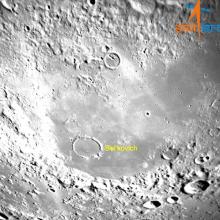Listen to today's episode of StarDate on the web the same day it airs in high-quality streaming audio without any extra ads or announcements. Choose a $8 one-month pass, or listen every day for a year for just $30.
You are here
Moon and Venus
The two brightest orbs in the night sky perch close together at first light tomorrow. The Moon will stand quite low in the southeast at dawn. The planet Venus — the brilliant “morning star” — will be close to the lower left. But there’s not a lot of time to watch them before daylight overpowers their glow.
The surface of the Moon is covered with craters — big round holes blasted out when big space rocks plowed into the Moon. The process has been going on for billions of years. That’s long enough for the older craters to have been partially destroyed by more recent impacts. So pictures of the Moon show craters on top of craters on top of more craters.
There are craters on Venus, too — about a thousand have been cataloged. Unlike the Moon, though, they all look young and fresh. That’s because volcanic activity “repaved” Venus a few hundred million years ago. So all the craters we see on Venus today have been carved since that resurfacing. And the planet’s atmosphere is so thick that it prevents most space rocks from reaching the surface — keeping Venus’s craters looking pristine.
Again, look for Venus and the Moon during morning twilight tomorrow. The view gets better as you go farther south, because the Moon and Venus rise at a steeper angle, so they climb higher into the sky. They’ll be closer together on Tuesday, but the Moon will be lower, making the viewing window even tighter.
Script by Damond Benningfield





